There is no question that high-intensity interval training (HIIT) is ideal for fat loss and preserving precious muscle tissue. There have been numerous studies, articles, blogs, etc. proclaiming the greatness of HIIT: It burns more calories, increases metabolism, increases EPOC (post-exercise oxygen consumption), preserves muscles, releases growth hormone, targets stubborn fat, reduces insulin resistance and increases endurance, all in a fraction of the time of long slow cardio.
There are limitless ways to implement HIIT into your workouts, whether through cardiovascular training, weight training or a combination of both. The basic take-home point of interval training is to achieve a high heart rate in the zone of 80 to 95 percent of your estimated max heart rate for a short duration of time, anywhere from 10 seconds to three minutes. Follow this with a brief cool-down period, bringing your heart rate back into a cardiovascular zone, usually about 50 to 75 percent of your max heart rate.
HIIT and Weight Training
You do not necessarily need to do “cardio,” even in the form of HIIT, to get the same results. If you are looking to increase your strength, endurance, build and preserve muscle all while burning fat so that your ideal figure shines through, then do HIIT weight-training workouts! The key is to move quickly from one exercise to another (like a circuit) with very little rest, while also incorporating higher-intensity exercise that raises your heart rate and makes you sweat. Your boring weight-training workouts will definitely feel like cardio, effectively killing two birds with one stone.
One of the biggest things to consider when designing a lower-body program is making sure that you train in all three planes of motion. Lower-body exercise should not only emphasize strength and toning, but also improve your daily function by mimicking movements you may encounter in your everyday life.
These movements include side-to-side, reverse, twisting, single-leg and high-intensity jumping motions. By incorporating all these movement patterns and energy systems, you will decrease your risk of injury, improve cardiovascular health and improve quality of life, all while decreasing body fat and increasing muscle!
CONSIDERATIONS
Everyone is individual and unique. Because of this, weights and intensities will vary, so specific weights are not provided. Your goal is to feel the burn and max yourself out by the number of repetitions listed. If the repetition range is eight, then you will lift a heavier weight than if the range was 15. This may take some guesswork and testing on your part. Pick a weight that you think you can handle for the listed reps. If it feels too light (like you could continue lifting that weight beyond the listed repetitions), increase the weight during the next round. Make a note of the weight you lift, so you can try to lift a little heavier every few weeks. Remember, gains and improvements are made when you step outside your comfort zone, so if you are “comfortable” lifting the weights, increase it a bit to achieve results faster and more effectively!
Guidelines
Always start each program with a five-minute light cardio warm-up.
Modify as necessary—these are merely guidelines, so push yourself, but don’t kill yourself. Work smart!
Get a heart-rate monitor. It makes it much easier to track your progress and get to within your estimated max heart rate. To find your estimated max heart rate, subtract your age from 220. For example, a 30-year-old man has an estimated max heart rate of 190, so 90 percent of his max heart rate is 162 beats per minute.
Form matters more than anything! You may be able to lift a weight for the given repetition range, but if you are struggling and your form is bad, decrease your weight until you can complete the set with good form.
Talk to a doctor before starting any new exercise program.
The Workout
The Fat Burning Leg Workout Circuit 1: Repeat 3 times.
Glute Bridge – 15 reps
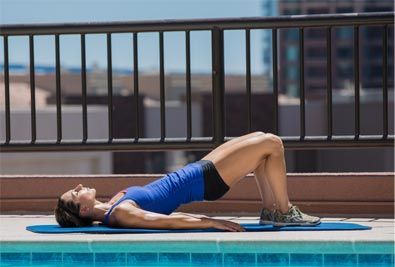
The glute bridge is a great initial exercise to help open your hips, stretch your hip flexors and activate your glutes. Too often when we train legs, the quadriceps is the first muscle group that activates, when the glutes should be the primary focus. Lie on your back with your legs bent and palms down by your sides. Keep your feet flat on the floor, but press through your heels to lift your hips into the air, finishing when your shoulders, hips and knees are in a straight line. Hold the top position and squeeze your glutes for a second, then slowly lower.
For an advanced progression, try placing one or both feet on a BOSU.
Squat Jumps – 15 reps
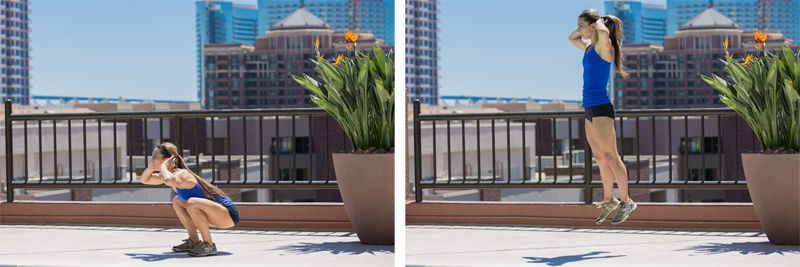
Stand with your feet about shoulder-width apart and execute a squat, hinging your hips back and keeping the majority of your body weight on your heels. Press through your heels and jump up. Try to land softly and absorb the floor and finish back in a squat.
Split Squat with Elevated Rear Leg – 8 to 10 reps per leg
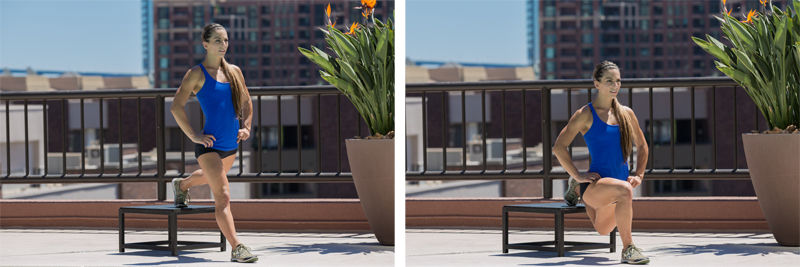
Place the top of your left foot, which will be your rear leg, onto a step or bench about 12- to 24-inches tall. Face away from the step and position the right foot about 2 to 3 feet in front of the bench. Bend your right knee and lower slowly, trying to get your right thigh parallel to the ground. This exercise is good for both a hip flexor stretch and glute/hamstring/quad exercise.
Modifications – If you are new to exercise, try a stationary split squat on the ground before elevating the back leg. Stand near something you can hold onto for balance. For a challenge, hold dumbbells or a barbell.
Jump Rope – 1 minute
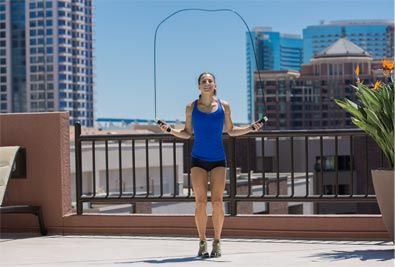
Circuit 2: Repeat 3 times.
Goblet Squat – 12 to 15 reps
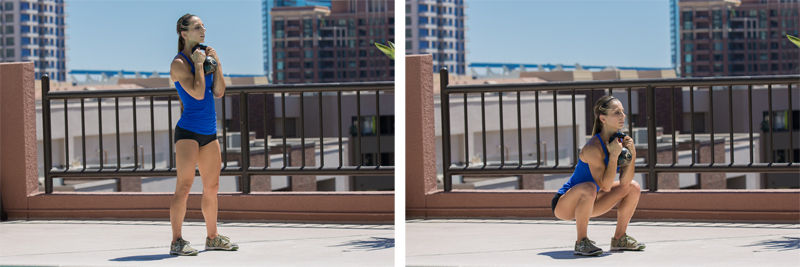
Using a kettle bell, hold it between the hands on the chest. With feet slightly wider than shoulder width and toes pointing slightly outward, squat down as low as possible with your heels on the ground and chest up. Make sure the elbows are in the inside of the knees and that the knees track over the center of the ankle/foot. Use your glutes and quads to push back up to standing.”
Jump Lunge – 10 reps per leg
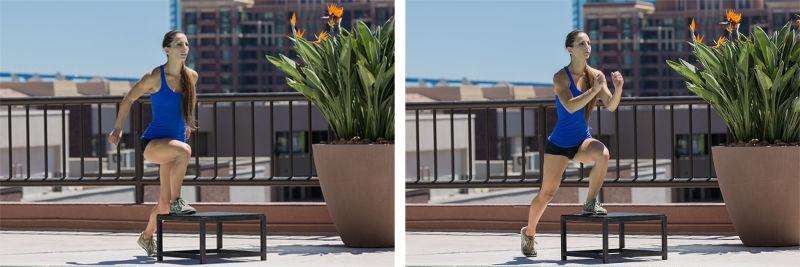
Make sure you have great form and are able to decelerate your movements so you don’t hit your back knee on the ground.
If you are new to exercise, try placing your front foot on a 6- to 12-inch step, and jump and switch legs, without the lunge. This will allow you to learn the movement pattern. As you get more comfortable, slowly increase the depth of your lunge. For advanced exercisers, try going for time, 30 to 60 seconds, instead of for reps.
Curtsey or Crossover Lunge – 10 per leg
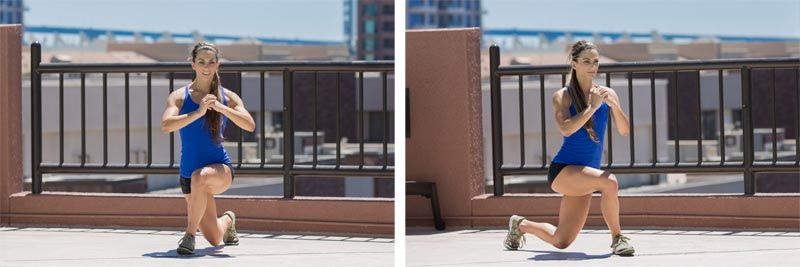
Stand with your feet shoulder-width apart. Stand on your left leg, and step back and to the left with your right leg, keeping the majority of your weight on your front leg. The finished lunge should look like a curtsey. Alternate legs and repeat.
Lateral Jumps – 30 seconds
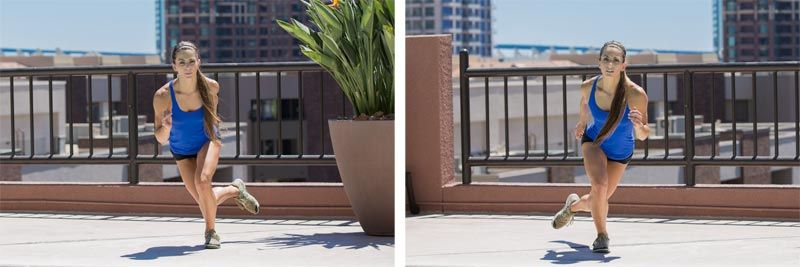
Stand on your left leg, and then jump sideways to the right to finish on your right leg. Pause for a second to establish balance, and then jump back to the left leg. Stay low to the ground and keep the knee bent upon impact. Make sure you have plenty of room because as you get stronger and gain stability, try to jump farther. This exercise helps establish lateral ankle, knee and hip stability and mimics the slalom.
If you are a beginner, start with small jumps and place your non-jumping leg on the ground behind you after each jump to balance.
Circuit 3: Repeat 3 times.
Forward Lunge With a Barbell — 8 to 10 reps per leg
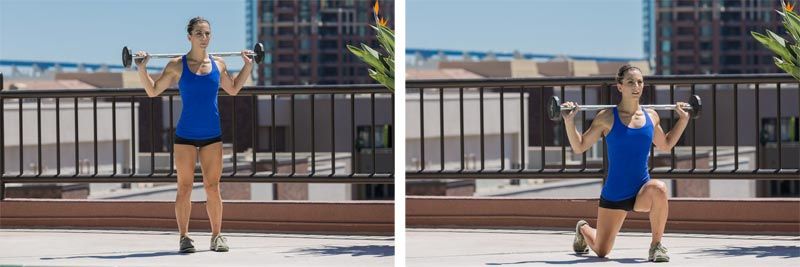
Stand with your feet together and place a 20- to 40-pound barbell over the back of your shoulders. Take a large step forward with your right leg into a lunge, making sure your front shin stays vertical so your knee does not move past your toes. Keep your torso upright; do not lean forward. Press your right heel into the ground to push yourself up back to a standing position. Repeat with the left leg.
Modifications – If you are new to the movement, try the exercise without additional weight to establish proper form. You may also start by holding dumbbells in each hand, and progress to a barbell as your strength increases.
Stationary Lunge With Medicine Ball Slam – 10 reps per leg
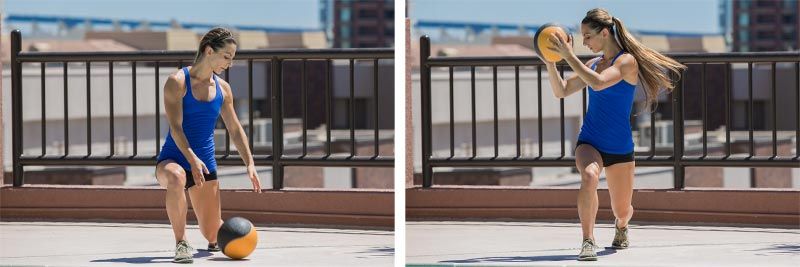
This exercise is great for building core and hip stability, while raising your heart rate. Stand in a wide split stance with the right leg in front and the left leg behind. Bend both knees evenly so you are in a high-lunge position. Hold a medicine ball, brace your core and slam it on the right side of your knee; catch it, then slam it on the left side of your knee, slowly rotating through your thoracic spine, while keeping your hips stable.
If you are a beginner, hold the lunge position and just work on your T-spine mobility by rotating your torso to the left and to the right without a medicine ball. Once you can do that, hold a ball, but do not slam it. If you are advanced, you can do this exercise in conjunction with a jumping lunge.
Single Leg deadlifts – 10 to 15 reps per leg
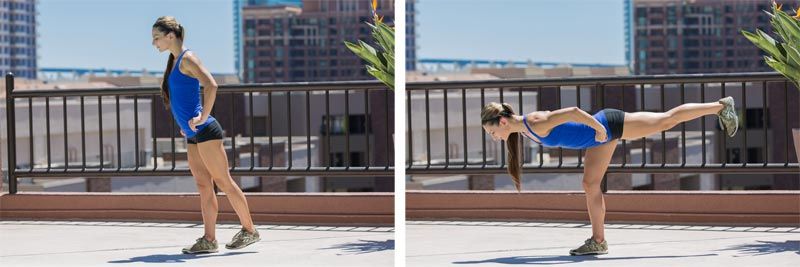
Stand on your right leg with knee slightly bent but stiff. Slowly hinge at the hips and lower your torso, while simultaneously lifting your left leg behind you to act as a counter balance. Keep your spine straight in neutral position. Continue to lower until you feel a stretch through your hamstrings, or until your torso is parallel with the ground. Squeeze your glutes to arrive back in a standing position.
If you are a beginner, stand next to something for balance. For advanced exercisers, hold a dumbbell in your opposing hand. If your right leg is on the ground, hold a dumbbell in your left hand, and vice versa.
Frog Thrusts With Jump – 10 to 15 reps
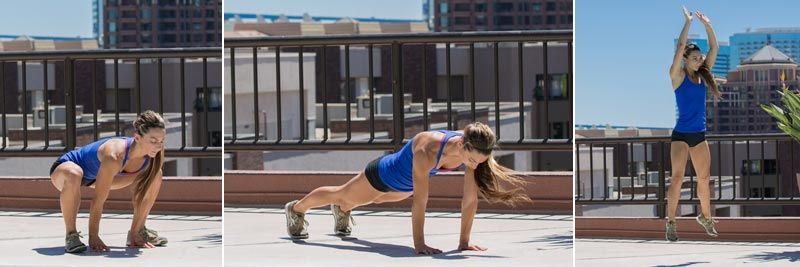
These are essentially burpees, minus the push-up and with your feet positioned wide instead of narrow. Start in push-up position, establishing a tight core and a proper plank. Jump your feet to the outside of your hands, trying to place your heels on the floor. Stand up and jump, then land in a squat position. Place hands back on the ground and finish back in push-up position.




 by
by 


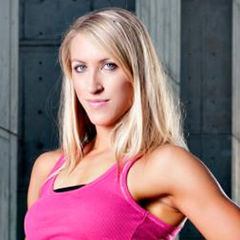






 by
by